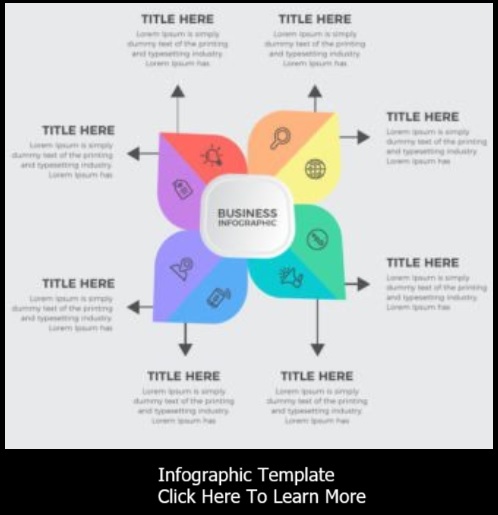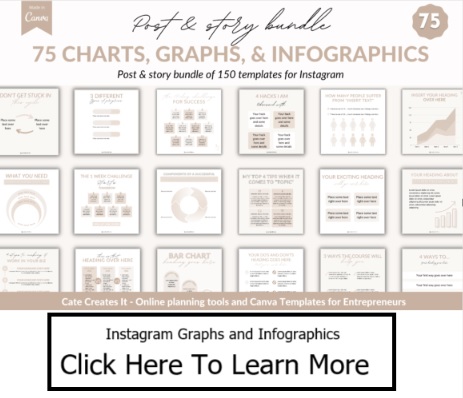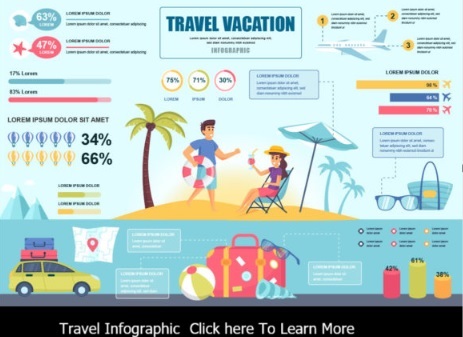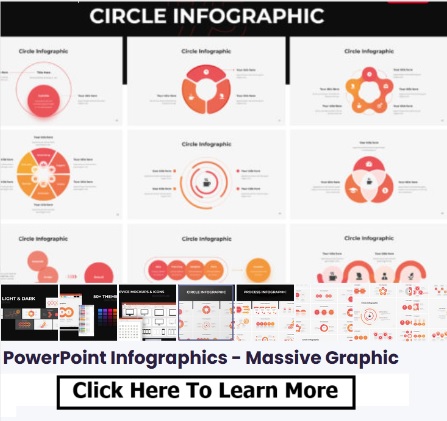Visual Powerhouse: Harnessing the Impact of Infographics in Presentations
In the realm of presentations, the saying "a picture is worth a thousand words" holds more truth than ever before. As attention spans dwindle and information overload looms, infographics emerge as the knights in shining armor. Integrating infographics into your presentations transforms mundane data into captivating stories, making your message not only informative but also engaging. Let's delve into how harnessing the power of infographics can elevate your presentations to new heights.
1. Simplifying Complex Concepts:
Presentations often involve explaining intricate concepts, data, or processes. Infographics excel at simplifying complexity. Whether it's a detailed workflow, a market trend analysis, or a scientific process, infographics visually break down information, making it easier for your audience to grasp the content quickly.
2. Enhancing Understanding:
The human brain processes visuals faster than text. By incorporating infographics, you streamline the process of understanding. Visual elements like charts, graphs, and diagrams add clarity, allowing your audience to comprehend the data more efficiently.
3. Capturing Attention:
Audience engagement is a top priority in presentations, and infographics are potent attention-grabbers. A well-designed infographic instantly draws the eye, enticing your audience to focus on the message you're conveying. This initial engagement sets the tone for a more receptive audience.
4. Storytelling Made Visual:
Infographics are inherently visual storytelling tools. They weave a narrative through a combination of images, icons, and text. This storytelling aspect engages the audience emotionally and makes your presentation more memorable. By appealing to both logic and emotion, you create a connection that lingers.
5. Data Visualization:
Presentations often involve sharing data and statistics. Infographics transform raw numbers into meaningful insights. Bar charts, pie graphs, and line diagrams offer a visual representation of trends and patterns, making data more accessible and impactful.
6. Guiding Through Processes:
Step-by-step processes can be cumbersome to explain verbally. Infographics provide a structured visual guide that simplifies complex processes. From assembling furniture to illustrating a workflow, infographics help your audience follow each step seamlessly.
7. Highlighting Key Points:
Infographics are effective at highlighting key points and takeaways. Whether it's a list of benefits, a timeline of achievements, or a comparison between options, infographics direct your audience's attention to the most critical aspects of your presentation.
How to Incorporate Infographics in Presentations:
-
Content Selection: Identify the areas in your presentation where infographics can enhance understanding and engagement. These could be data points, processes, comparisons, or complex concepts.
-
Design for Clarity: Work with a skilled designer or use user-friendly design tools to create clear, coherent infographics that align with your presentation's theme and message.
-
Integrate Seamlessly: Infographics should seamlessly complement your presentation's content. Introduce them at appropriate points to enhance the narrative and support your verbal explanations.
-
Maintain Consistency: Ensure that the design elements, color palette, and typography of your infographics align with your overall presentation design for a cohesive visual experience.
-
Engage with Interaction: In digital presentations, consider creating interactive infographics that allow your audience to explore data or processes on their own.
-
Practice and Feedback: Practice your presentation with the integrated infographics to ensure smooth transitions. Gather feedback from peers to refine the visuals and content.
Incorporating infographics into your presentations transforms them from static information delivery tools to engaging visual experiences. By making your content more accessible, relatable, and visually appealing, infographics enhance the effectiveness of your message. Whether you're presenting to clients, colleagues, or a wider audience, infographics are a valuable tool that empowers your presentation to resonate and leave a lasting impact.
- A Guide to Different Types of Infographics
- Cooking Up Visual Delights: The Role of Infographics in Cookbooks
- Decoding Visual Communication: Infographic vs. Poster
- Five Types Of Infographic Articles
- Infographics in Press Releases: Communicating Complexity with Clarity
- The Art of Visual Storytelling: Unveiling the 5 Key Elements of Infographics
- The Power of Infographics: Enhancing Articles with Visual Storytelling
- Transforming Content: 7 Engaging Types Perfect for Infographics
- Visual Persuasion: Leveraging Infographics in Sales Brochures as a Powerful Marketing Tool
- Visual Powerhouse: Harnessing the Impact of Infographics in Presentations
Visual Persuasion: Leveraging Infographics in Sales Brochures as a Powerful Marketing Tool
In the world of marketing, where attention spans are fleeting and competition is fierce, a well-crafted sales brochure can make all the difference. However, gone are the days when lengthy paragraphs alone could capture a potential customer's interest. Enter infographics – dynamic visual tools that transform mundane data into captivating stories. Let's delve into how incorporating infographics into your sales brochures can elevate your marketing strategy to new heights.
1. Simplifying Complex Information:
Sales brochures often need to convey intricate details about products, services, or offerings. Infographics break down complex information into easily digestible visual chunks. Whether it's explaining the features of a tech product or outlining the steps of a service process, infographics make your content more approachable, increasing the likelihood of readers engaging with and comprehending the details.
2. Grasping Attention Instantly:
Visuals are a potent magnet for attention. Infographics catch the eye of your audience quickly, encouraging them to stop and take a closer look. A visually appealing infographic acts as a "hook" that entices readers to explore the rest of your brochure, giving you a precious opportunity to communicate your message effectively.
3. Engaging and Memorable:
Infographics combine text and imagery to tell a story. This storytelling aspect engages the reader emotionally and makes the information more memorable. When you evoke an emotional response through visuals, you create a connection that lasts longer in your potential customers' minds.
4. Showcasing Benefits and Value:
Infographics are fantastic for highlighting the value and benefits of your products or services. Instead of listing features in a dry manner, use visuals to demonstrate how your offerings address your customers' pain points and fulfill their needs. Whether it's showcasing before-and-after scenarios or a process map, infographics add weight to your value proposition.
5. Comparing Options:
Sales often involve comparisons, and infographics are excellent for visually presenting these options. Whether you're comparing features, pricing tiers, or product versions, side-by-side infographics make it easy for your potential customers to weigh their options and make informed decisions.
6. Enhancing Brand Perception:
Well-designed infographics not only make your content easier to understand but also elevate your brand's image. A professionally crafted infographic showcases attention to detail, professionalism, and a commitment to delivering quality. This positive perception can influence how potential customers view your products or services.
7. Sharing on Multiple Platforms:
Sales brochures may be printed or digital, and infographics seamlessly adapt to both formats. They are easily shareable on social media, websites, and emails. The shareability factor expands your brochure's reach, allowing your marketing message to spread organically.
How to Incorporate Infographics in Sales Brochures:
-
Identify Key Points: Determine the most important information you want to convey in your brochure. These can include benefits, features, comparisons, statistics, and processes.
-
Choose the Right Type: Select the type of infographic that best suits your content, whether it's a process infographic, comparison infographic, data visualization, or a combination of styles.
-
Craft Clear Visuals: Work with a skilled designer to create visually appealing and coherent infographics that align with your brand's aesthetics.
-
Complement Text: Infographics should complement the textual content in your brochure. Use them strategically to enhance key points and make the content more engaging.
-
Maintain Consistency: Ensure that the design elements, color palette, and typography of your infographics align with your brand identity and the overall design of the brochure.
-
Test and Refine: Test your brochure with target customers to gauge their response to the infographics. Refine the design and content based on feedback.
Incorporating infographics into your sales brochures isn't just a design choice; it's a strategic move that can significantly impact your marketing efforts. By making your content more engaging, comprehensible, and visually appealing, infographics enhance the effectiveness of your sales messages and elevate your brand's image. Whether you're promoting products, services, or solutions, infographics are a valuable tool that empowers your marketing strategy to reach new heights of success.
Cooking Up Visual Delights: The Role of Infographics in Cookbooks
Cookbooks have long been cherished companions for both novice and experienced chefs, guiding them through culinary adventures. While recipes are the heart of any cookbook, the addition of infographics is like adding a dash of creativity and a pinch of visual appeal to the mix. Let's explore how infographics can spice up cookbooks, making them even more engaging and user-friendly.
Bringing Clarity to Techniques:
Cooking techniques can sometimes be intricate and challenging to convey through text alone. Infographics come to the rescue by visually illustrating these techniques step by step. From chopping techniques and knife skills to braiding dough or assembling complex dishes, infographics provide clear visual guidance that enhances readers' understanding and confidence in the kitchen.
Simplifying Measurements and Conversions:
The world of cooking involves a variety of measurements and conversions that can sometimes lead to confusion. Infographics can simplify this aspect by presenting common measurement conversions visually. Whether it's converting cups to grams or Fahrenheit to Celsius, infographics offer quick references that eliminate guesswork and potential mishaps.
Visual Ingredient Pairing:
Flavor combinations can make or break a dish. Infographics can showcase which ingredients pair well together, helping chefs experiment with new flavors while ensuring harmonious results. This is particularly helpful for those looking to get creative in the kitchen or trying out unique and unexpected flavor combinations.
Nutrition Information:
For health-conscious cooks, infographics can present nutritional information in a visually appealing manner. Highlighting the nutritional content of ingredients or recipes, including calories, macronutrients, and vitamins, can help readers make informed choices while cooking.
Cooking Time and Temperatures:
Infographics are excellent tools for illustrating cooking times and temperatures for various dishes. Whether it's the perfect doneness of meats, ideal oven settings, or the duration for achieving the right texture in a recipe, infographics provide quick references that streamline the cooking process.
Plating and Presentation Techniques:
Cooking isn't just about flavors; presentation matters too. Infographics can guide cooks on plating techniques, helping them create visually stunning dishes. From garnishing to arrangement tips, these visuals add an artistic touch to the culinary experience.
Ethnic and Regional Cuisine Insights:
When exploring different cuisines, understanding the unique ingredients, cooking methods, and cultural significance is essential. Infographics can offer insights into the key elements of various ethnic and regional cuisines, providing a window into the culinary traditions and practices of different cultures.
How to Incorporate Infographics:
-
Visual Recipe Steps: Use infographics to illustrate the step-by-step process of a recipe, especially for complex dishes.
-
Measurement Charts: Include infographics that depict common measurement conversions for both liquid and dry ingredients.
-
Pairing Guides: Create infographics that showcase ingredient pairings for different flavor profiles.
-
Cooking Techniques: Illustrate essential cooking techniques, from searing and sautéing to braising and roasting.
-
Nutritional Insights: Present nutritional information for key ingredients or entire recipes in an easy-to-understand visual format.
-
Regional Insights: Introduce infographics that provide insights into the culinary traditions and ingredients of specific regions.
-
Cooking Times and Temperatures: Design infographics that offer cooking time and temperature guidelines for different types of dishes.
Cookbooks enriched with infographics become not only sources of culinary knowledge but also engaging visual experiences. By incorporating these visual elements, cookbook authors can cater to a broader audience, including visual learners, beginners, and those seeking inspiration in the kitchen. Infographics bring cooking to life, making recipes more accessible, comprehensible, and ultimately, more enjoyable.
- A Guide to Different Types of Infographics
- Cooking Up Visual Delights: The Role of Infographics in Cookbooks
- Decoding Visual Communication: Infographic vs. Poster
- Five Types Of Infographic Articles
- Infographics in Press Releases: Communicating Complexity with Clarity
- The Art of Visual Storytelling: Unveiling the 5 Key Elements of Infographics
- The Power of Infographics: Enhancing Articles with Visual Storytelling
- Transforming Content: 7 Engaging Types Perfect for Infographics
- Visual Persuasion: Leveraging Infographics in Sales Brochures as a Powerful Marketing Tool
- Visual Powerhouse: Harnessing the Impact of Infographics in Presentations
Infographics in Press Releases: Communicating Complexity with Clarity
In the fast-paced world of media and communication, capturing the attention of journalists, readers, and stakeholders is essential. Amid the deluge of information, a well-crafted press release can make all the difference. However, traditional press releases might sometimes fall short when it comes to conveying complex information effectively. This is where infographics step in as a powerful tool for enhancing press releases and amplifying their impact.
Why Use Infographics in Press Releases?
-
Visual Engagement: Infographics combine visuals and text to create a compelling visual story. They instantly draw the reader's eye and encourage engagement, making your press release stand out in a sea of text-based communications.
-
Simplifying Complex Information: Press releases often involve intricate data, statistics, and processes that may be challenging to understand at a glance. Infographics simplify complexity by breaking down information into digestible visual elements, enhancing comprehension.
-
Increased Shareability: Infographics are highly shareable across various platforms, including social media, websites, and emails. Journalists and readers are more likely to share visually appealing content, thereby increasing the reach and visibility of your press release.
-
Quick Information Absorption: In today's fast-paced digital landscape, readers tend to skim through content. Infographics allow key information to be absorbed rapidly, ensuring that crucial details are communicated even to those who only have a moment to spare.
-
Visual Storytelling: Infographics can tell a story more effectively than plain text. They guide readers through a narrative, helping them connect the dots and follow the logical flow of information. This narrative structure makes your press release more engaging and memorable.
How to Incorporate Infographics in Press Releases?
-
Choose the Right Content: Identify the complex information within your press release that can be better communicated through visuals. This could include data trends, process explanations, comparisons, and statistics.
-
Design for Clarity: Work with a skilled graphic designer or use user-friendly design tools to create clear and aesthetically pleasing infographics. Use a consistent color palette, typography, and layout that align with your brand identity.
-
Complement the Text: Integrate infographics strategically within your press release to complement the textual content. Use them to enhance key points, provide context, and simplify intricate details.
-
Create a Visual Hierarchy: Ensure that your infographics maintain a clear visual hierarchy. Emphasize the most important information through visual cues such as size, color, and positioning.
-
Provide Context: Accompany your infographics with concise captions or explanations. While infographics are excellent at simplifying information, providing context ensures that readers understand the significance of the visual representation.
Examples of Infographics in Press Releases:
-
Financial Reports: Use infographics to display quarterly earnings, revenue breakdowns, and financial projections in a more accessible manner.
-
Product Launches: Create infographics showcasing product features, benefits, and comparisons with competitors' offerings.
-
Event Announcements: Design infographics to provide event schedules, venue maps, and highlights to entice attendees.
-
Industry Insights: Use infographics to illustrate market trends, growth projections, and statistical data relevant to your industry.
Incorporating infographics into your press releases elevates your communication strategy, making your content more engaging, understandable, and shareable. By presenting complex information visually, you enhance the impact of your press release, ensuring that your message resonates with your target audience and stands out in the competitive media landscape.
- A Guide to Different Types of Infographics
- Cooking Up Visual Delights: The Role of Infographics in Cookbooks
- Decoding Visual Communication: Infographic vs. Poster
- Five Types Of Infographic Articles
- Infographics in Press Releases: Communicating Complexity with Clarity
- The Art of Visual Storytelling: Unveiling the 5 Key Elements of Infographics
- The Power of Infographics: Enhancing Articles with Visual Storytelling
- Transforming Content: 7 Engaging Types Perfect for Infographics
- Visual Persuasion: Leveraging Infographics in Sales Brochures as a Powerful Marketing Tool
- Visual Powerhouse: Harnessing the Impact of Infographics in Presentations
Transforming Content: 7 Engaging Types Perfect for Infographics
In the world of content creation, the adage "a picture is worth a thousand words" holds true, especially when it comes to infographics. These visually captivating tools have the power to simplify complex ideas, making them accessible and engaging to a wider audience. If you're seeking to breathe life into your content, consider these seven types that seamlessly lend themselves to the world of cool infographics.
1. Statistical Insights: The Power of Numbers
Numbers have the potential to tell compelling stories, but they often come across as dry when presented in traditional formats. Infographics, however, can transform statistical data into eye-catching visuals. Whether you're showcasing market trends, survey results, or financial statistics, infographics make numbers relatable and impactful.
2. Step-by-Step Guides: Visualizing Processes
Do you have a comprehensive guide, tutorial, or how-to article? Infographics are perfect for translating step-by-step instructions into an intuitive visual format. From assembling furniture to creating intricate recipes, infographics break down processes, eliminating confusion and making your content easy to follow.
3. Historical Evolution: Timelines Unveiled
Narrating historical events can be a daunting task, but infographics turn this challenge into an opportunity. With the ability to depict the passage of time, timelines are ideal for mapping out historical narratives, technological advancements, or cultural shifts. Visualizing events along a chronological line brings history to life in an engaging way.
4. Comparisons and Contrasts: The Power of Choice
When you need to compare products, services, ideas, or options, infographics provide a clear and concise format. Through side-by-side visuals, infographics highlight differences and similarities, helping readers make informed decisions. Comparisons infographics are particularly useful in reviews, evaluations, and analyses.
5. Data Visualization: Unveiling Insights
Complex data can overwhelm readers, but data visualization infographics offer a solution. Pie charts, bar graphs, scatter plots, and more visually convey trends, patterns, and relationships within data sets. Whether you're demonstrating market share or illustrating a scientific study, data visualization infographics make data understandable at a glance.
6. Explaining Concepts: Simplifying Ideas
From scientific theories to philosophical concepts, infographics excel at simplifying complex ideas. Through the strategic combination of visuals and concise text, these infographics break down abstract concepts, making them accessible to a broader audience. If you have a concept that's challenging to grasp, an infographic can make it relatable.
7. Visual Storytelling: A Picture-Driven Narrative
Some content is best told through a visual journey. Storytelling infographics combine text and imagery to narrate a sequence of events, explain cause-and-effect relationships, or convey a captivating story. These infographics engage readers by guiding them through a structured narrative, enhancing the emotional impact of your content.
In a digital landscape where attention spans are short and information is abundant, infographics are a powerful tool to enhance engagement and understanding. By transforming your content into cool infographics, you're not only making it visually appealing but also ensuring that your message resonates with your target audience. From statistics to step-by-step guides, the possibilities are endless when it comes to turning your content into compelling infographics.
- A Guide to Different Types of Infographics
- Cooking Up Visual Delights: The Role of Infographics in Cookbooks
- Decoding Visual Communication: Infographic vs. Poster
- Five Types Of Infographic Articles
- Infographics in Press Releases: Communicating Complexity with Clarity
- The Art of Visual Storytelling: Unveiling the 5 Key Elements of Infographics
- The Power of Infographics: Enhancing Articles with Visual Storytelling
- Transforming Content: 7 Engaging Types Perfect for Infographics
- Visual Persuasion: Leveraging Infographics in Sales Brochures as a Powerful Marketing Tool
- Visual Powerhouse: Harnessing the Impact of Infographics in Presentations




